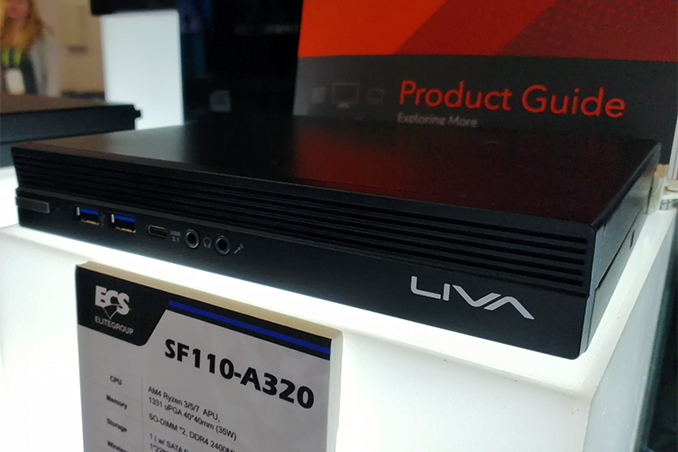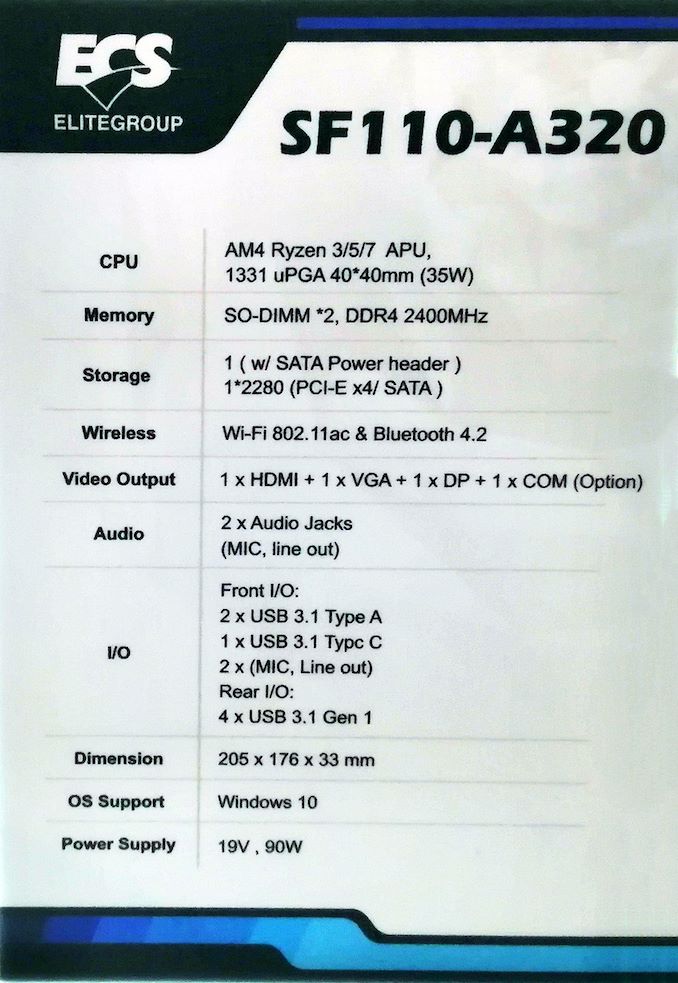CES 2019: ECS SF110-A320 Ultra-Compact PC using AMD Ryzen
by Anton Shilov on January 17, 2019 5:00 PM EST
One of the market segments that AMD has not yet established a meaningful presence in with its Ryzen processors is the ultra-compact form-factor (UCFF) PC market. AMD's limited progress here comes despite the fact that the company introduced suitable low-power Ryzen APUs for desktops a while ago. However things have finally begun to change as of late, after a number of PC makers introduced miniature systems featuring Ryzen chips. One of these companies is ECS, which announced its miniature SF110-A320 PC at CES.
Measuring 205×176×33 mm, the ECS SF110-A320 is based on AMD’s 35W quad-core Ryzen desktop processors with Radeon Vega graphics, and is paired with AMD’s A320 chipset. The APUs will be paired with two DDR4-2400 SO-DIMMs and an M.2-2280 slot for a PCIe or SATA SSD. The system will be equipped with a 90 W PSU, which is more than enough to feed an APU, memory, SSD, and various USB peripherals.
Connectivity-wise, the SF110-A320 UCFF PC offers an essential set of physical and wireless interfaces, including an 802.11ac Wi-Fi + Bluetooth controller, a GbE, three display outputs (DisplayPort, D-Sub, and HDMI), one USB 3.1 Type-C port, and six USB 3.1 Type-A ports.
While ECS demonstrated its SF110-A320 at CES 2019, the company has not revealed much information about its positioning. On the one hand, the system lacks has GbE, which is crucial for offices, but is not that important for living room HTPCs. On the other hand, the latter tend to feature hard drives in a bid to keep certain content locally without using expensive high-capacity SSDs. Keeping in mind that the product is an early prototype, ECS does have time to tweak their design if necessary. Either that, or it has a potential expansion market in digital signage.
UPDATE 1/25: ECS has informed us that the system indeed has a GbE port.
Without any doubts, there is a growing interest in AMD Ryzen processors across all market segments, especially given the success of the desktop platform. So it is not surprising that companies like ECS are announcing UCFF systems featuring Ryzen APUs. In the coming months we will see more compact PCs powered by AMD’s latest APUs and CPUs.
Related Reading:
- ASRock at CES 2019: DeskMini A300, World’s First AMD Ryzen Mini STX PC Launched
- ECS Announces LIVA Z2 and LIVA Z2V Mini PCs
- Gemini Lake SFF PC Showdown: Intel's June Canyon (NUC7PJYH) and ECS's LIVA Z2 Reviewed
Source: ECS












29 Comments
View All Comments
AshlayW - Friday, January 18, 2019 - link
It has slightly higher latency but significantly more bandwidth. DDR4 only really gets universally better than DDR3 when you hit the 3000 MHz mark.nevcairiel - Friday, January 18, 2019 - link
Timings have largely stayed constant, and bandwidth increases substantially. 2400 CL16 is particularly bad on the timing side, though. I have 3200 CL14 modules, which isn't even that high-end, which has excellent timings and decent bandwidth.Always remember that you cannot compare the cycle count verbatin, since it is in relation to the clock. If you double the clock, you can also double the CAS cycles without increasing the absolute latency. So a 3200 CL14 not only has significantly higher bandwidth then your DDR3 modules, but also lower absolute latency (8.75ns vs your 10.5ns)
willis936 - Friday, January 18, 2019 - link
RAM tech has not become stagnant. 50 ns is a fundamental limitation of SDRAM. Lower latency RAM has existed for as long as RAM has existed. Want faster and lower latency RAM? Reduce your density by a factor of six and cough up a lot of dough. The chips exist, they're just not the best solution for mainstream computing.Samus - Saturday, January 19, 2019 - link
The focus has been on reduced power consumption and increased density. RAM performance hasn't been an issue for mainstream CPU architecture for some time. Even Intel CPU's show negligible difference going from dual-channel to single-channel (which is why most OEM's still sell systems as the later. Intel has also scaled back on triple and quad channel systems even in the HEDT market. It just isn't where the bottleneck is. RAM is SO fast that Intel considered making is SLOWER with the whole concept behind X-point. There is more of a need for capacity (in the terabytes) because the focus needs to flip back to performance. As it is most large memory systems can completely clear and refresh themselves in under a second (a DDR4-4000 interface on the X299 can transfer 130GB/sec and handles 128GB of memory)As cache sizes on CPU's get larger and branch prediction units get better, there is no need to cache out to RAM as much.
The only thing that really benefits from faster RAM is the iGPU.
KateH - Thursday, January 17, 2019 - link
looks nice! no GbE is a bummer though.On a sidenote, what happened to the A300 chipset? That was supposed to be a platform for ultracompacts that reduced the motherboard footprint by entirely omitting the Southbridge and instead relying soley on the SATA/USB/Audio functionality that's built into the APUs. Sounded neat when it was announced at Ryzen launch but I haven't heard a peep about it since...
GreenReaper - Friday, January 18, 2019 - link
Agreed, but there are relatively cheap USB 3.1 to Ethernet dongles that can do 5 Gbps.romrunning - Friday, January 18, 2019 - link
However, with a wired connection, some businesses would consider it. Not having even cheap 10/100 definitely limits the appeal for business.Frankly, it's not like they don't the space for it, so cheaping out in this case is just cheap. This UCFF isn't even NUC size, and yet a NUC has a GB port.
SquarePeg - Thursday, January 17, 2019 - link
At least they found a use for all those leftover PlayStation 2 cases.Lord of the Bored - Thursday, January 17, 2019 - link
Eh, Sony stole the design from Atari anyways.https://forum.digitpress.com/forum/showthread.php?...
The_Assimilator - Friday, January 18, 2019 - link
How does any company justify omitting wired Ethernet? Seriously...